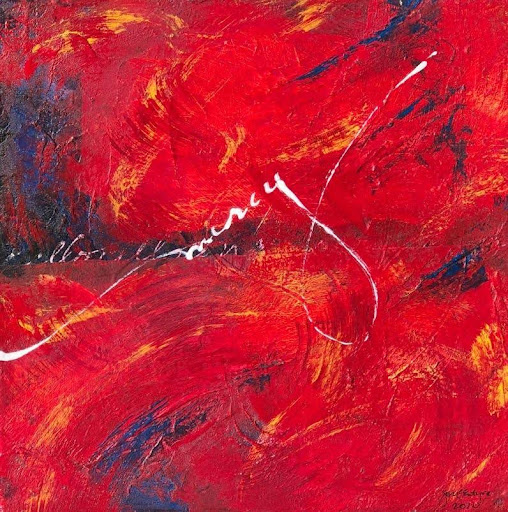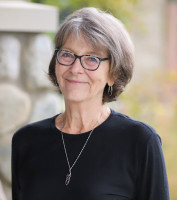Why make art at a time like this? Or write poems? We wake every day to new urgencies, deepening dread of deportations and the dismantling of agencies that serve the poor. The planet is warming and storms surge in unexpected places. Still, we make art and write poems.
A work of art is an invitation to the interior. It’s an invitation to stop for a moment and adjust our vision. It’s a reminder that there are more things in heaven and earth than the morning news. And that when we pause in unaccustomed places, when the syntax of our sentences is disrupted and the sharp lines dividing one thing from another dissolve, we get a glimpse of something that is also true: the nouns are verbs. The sharp lines between one thing and another are convenient fictions. Fluidity is a fact of life. The Spirit blows where it will and leaves its traces. Now and then we notice, and find new reason to rejoice.
The paintings below are by John McEntyre, the poems, written in response to the paintings, by Marilyn McEntyre. We share them here in hope that they might serve as reminders of what remains and resurges.

In the midst of it all, mercy
overwrites every ominous
foretelling, every anxious
unknowing. We are covered,
by it, upheld, cradled
by night and by day released
into its wide welcome.

“Love is the unfamiliar name
Behind the hands that wove
The intolerable shirt of flame.”
In the swirling heat
of blazing afternoons
a message: here,
on the hottest day,
on a warming planet,
where salt waters rise,
love weaves a bright
garment for a ceremonial
moment whose time
has not yet come.
On every season
Love leaves its traces—
in veins of brightening leaves,
on pocked beaches
where sandpipers dart and feed,
in ribbons of light
on iced-over ponds
and in shy buds.
Fierce and fiery,
Love bursts from dying
maples, cries aloud
in sunsets almost too
bright to bear. Born
into it, we die into it,
safe in the fearsome force
of its embrace.

It is all around us,
steadfast and fleet
as fire. It burns like
a bush, wild, joyous,
crackling in the air
we breathe, making
holy the ground.

Justice rolls down like this—
It swells and roils, gathering,
crashing, deepening its course,
rising to meet the troubled air.
Here and there in calm pools
living things take their rest.

In the beginning, breath.
In the beginning, void.
Then form. Light. Darkness.
The great heartbeat,
galaxies flung, and planets,
in divine exuberance.
Finally, in the starlit expanse,
a deep, satisfied calm:
It is good.
Let it be.


9 Responses
Beautiful!! Thank you!!! We were commanded to love one another……. How did we become so distracted by freedom? Years ago, a campus minister asked us to ponder the difference between the capitalist concept of freedom (TO do, speak, think, make and hold onto money) and the communist concept of freedom (FROM the fear of starvation, lack of health care, housing, etc.). Let us seize the opportunity we have today, in this country, to be merciful! P.S. I’m not a communist, but I do think capitalism needs some major tweaking!
Thank you for the reminder to create art and spend time with beauty.
A beautiful duo of visual and written art—and a dire reminder that the fine arts and the liberal arts are continually at risk in pursuit, in development, and in emphasis in education at all levels.
Oh, this is lovely! The vibrancy of the paintings, and the freedom and expansion I feel when I read your words. Thank you for lifting my eyes higher.
Thanks. Inspiring art! For an interesting theological reflection on the role of art and the nature of God and creativity, I recommend the book I’m now reading by Dorothy Sayers, The Mind of the Maker.
So beautiful and true! Especially your reminder that “there are more things in heaven and earth than the morning news”. Then the vibrant reminders of art and poetry that lift us above the mundane and frightening, pointing us to the love and mercy that swirls around us. Thank you seems inadequate, but it will have to do.
What a beautiful interaction between different art forms! Thank you, Marilyn, for nourishing our souls with your blog!
Beautiful! Thank you, Marilyn. I resonated with the “invitation to the interior” even as I was reminded of Makoto Fujimura’s words in Art and Faith: A Theology of Making. He calls artists “border-stalkers,” who operate in the margins and “can help to mediate the divided realities and bring the wholeness of the gospel message” (p. 46). I may start scrolling the news at night because I want to stay informed and involved, but the mire of fearful resignation (or worse, hopeless resignation) is always closer than I would like. Next time I feel it creeping in, I hope I take an intentional step in to the interior and out to the margins. Both will offer a better look at what I’m truly meant to see. And maybe I’ll grab a paintbrush too.
Marilyn and John,
I was delighted to find a link to this post via the Hearts and Minds bookstore today.
Your shared companion pieces of poetry and art have illuminated my day! Thank you.